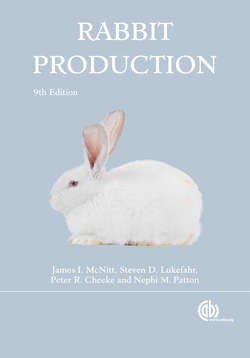Читать книгу Rabbit Production - James I McNitt - Страница 37
На сайте Литреса книга снята с продажи.
Watering Equipment
ОглавлениеAll rabbit raisers with more than about six does should consider installing an automatic watering system. A properly designed and installed automatic watering system will provide a dependable supply of water and prevent water siphoning from cage to cage. Most rabbits readily learn to use the automatic valves (Fig. 4.12). An automatic watering system is adequate for use throughout the year in rabbitries that are protected so the exposed water pipes will not freeze, but where there is more exposure, it may be necessary to drain the pipes during short cold spells. In some colder areas, such a system can be used all year if it is allowed to drip to prevent the supply pipes from freezing or if heating cables are installed inside the pipes to prevent freezing. Even in regions where it would be necessary to discontinue using the system during the winter months, the amount of labor saved for the remainder of the year might justify installation.
Fig. 4.12. A rabbit drinking from an automatic waterer. (Courtesy of J.I. McNitt)
You may locate necessary materials for installation by referring to advertisements in rabbit magazines, or you may purchase them from rabbit and poultry supply houses. A system generally will consist of a pressure tank equipped with a float valve; 1.25 cm supply pipe; one watering valve for each cage; and gate valves or faucets for eliminating air bubbles, draining the pipes, and cutting off the water supply. The pressure tank may be the standard tank used for this purpose or a halfbarrel. A tank with a capacity of 4 l or less is desirable for warm areas because the small volume of water will be consumed readily and the tank will fill at short intervals and assist in keeping the water in the supply pipes cool; the half-barrel will supply several hundred cages and is especially useful in case the water supply contains sediment. By installing the supply pipe outlet several inches from the bottom of the barrel, there will be enough water volume so this sediment will gravitate to the bottom of the barrel and not clog the watering valves. A trap for catching sediment may be installed between the tank and the supply pipe that furnishes water to the cages.
The pressure tank should be about 30 to 60 cm above the highest cage or 30 cm above the highest point of the supply pipe, in case it is necessary to raise the supply pipe to clear feeding alleys, etc. If the pipe has to be raised, it is a good plan to install a vent pipe at the highest point, with the open end of the pipe at least a foot above the surface of the water in the tank, to prevent air bubbles from accumulating in the supply pipe. A convenient method for determining the proper height of the tank is to fasten a rubber hose to the outlet from the tank and to the supply pipe, then to raise and lower the tank until the proper tension is obtained on the water valves. About 14 kPa (2 lb/square inch) at the valves is suitable. If there is too much pressure, the rabbit cannot trip a valve with its tongue; if there is too little pressure, the valves will not close properly and may drip. Several days are usually required for the valves to become seated and stop dripping. If they begin to drip after they have been in use for some time, it may be due to minerals contained in the water collecting on the metal and preventing them from seating properly. You can correct this by soaking the valves in a 5 percent solution of muriatic acid. Generally, you can fix a dripping valve by removing and cleaning it. If not, it should be replaced, because water dripping in the rabbitry contributes to excess humidity.
The supply pipe should be on the outside of the cage so that any dripping will not wet the rabbits and so that the water line cannot be chewed on. The valves should be 15 to 23 cm from the cage floor for the medium weight and heavy breeds and 13 to 18cm for the small breeds. One valve for each cage is adequate. After an automatic watering system is installed, it should be thoroughly flushed several times to remove any particulate matter that may cause the valves to leak. It is advisable to flush and sanitize the water lines monthly, quarterly, or as needed. After sanitizing, the lines should be flushed with clean water.
